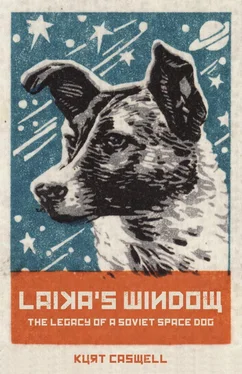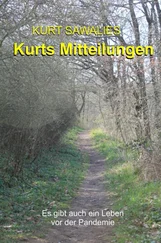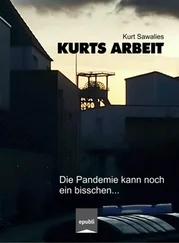In this next series of flights, instead of flying in a sealed capsule, the dogs would wear a pressurized space suit with a helmet and ride in a protective metal framework, or chassis, that would be ejected from the spacecraft at different altitudes during the descent to the ground. The flights would go like this: the rocket would ascend to an apex altitude of sixty-two miles, the very edge of space. Here the nosecone of the rocket would separate from its booster. On its descent, the first dog would be ejected at fifty miles altitude, and the chute would open at about forty-seven miles altitude, giving it a long, mostly gentle ride back to Earth. The nosecone would continue to fall, and at twenty-eight miles altitude the second dog would be ejected. Its chute would not open until about two miles altitude, leaving the dog to freefall for a full twenty-six miles, straight down. The chute on the nosecone itself would open before that, at about four miles altitude.
For the first time, telemetry would be used to relay information to the ground crew, especially the space dogs’ heart rate, blood pressure, respiration, and urine output, if any, as well as the temperature inside the space suit. The oxygen supply was to last two hours, and at 12,000 feet the dog would move off the bottled oxygen when a valve opened to allow breathable air to flow into the helmet.
¤
Despite steady improvements, rocket flight was dangerous, and a number of space dogs died. Lisa 2 (Fox) flew again on July 26, 1954, before she was killed in a flight on February 5, 1955. Her partner on the flight, Bulba, was also killed. Fox was an all-white dog with longer, soft-looking fur and a friendly face. File photos show her right ear standing tall while her left ear is cocked to the side. She was a favorite of Alexander Seryapin, and reciprocally he was a favorite of hers. “When [Fox] went about with [her] guard it was best to keep your distance,” Seryapin said in Space Dogs , “otherwise the guard would snap at your trouser legs.” The team around Kapustin Yar laughed about that, such a little dog with a big bite, always guarding Seryapin. Annoying sometimes, sure, but endearing too. Then “a time came when I had to put Fox into her space suit and send her on a flight,” Seryapin said. “I was well aware an animal shooting up to a height of 110 kilometers doesn’t bear the stress so well. So I put Fox into the [spacecraft] so she could see the Earth while descending from 90 kilometers. Unfortunately the rocket veered to one side, and when the rocket tried to correct itself there was a sharp jolt that threw Fox out of the [spacecraft] into the atmosphere in her space suit. The jolt was so strong that the animal was dead before she fell to Earth.”
The program’s secrecy forbade memorials for the dogs, but Seryapin defied this regulation to bury Fox in the wild steppe. He photographed her gravesite. Did he intend to return one day to honor her, to sit beside the little mound of her tucked up against a hummock in the shade of a saxaul thicket? Did he intend to steal away from his barracks in the night to visit her, his silhouette on a hilltop dune going over it, and off into the empty lands, the bark of golden jackals coming up for him out of the distance? Did he have words to say when he laid her in?
¤
Spaceflight and exploration were the greatest challenges in aviation medicine, and naturally the field attracted some of the best scientific minds. In summer 1956 medical doctor Oleg Gazenko joined Yazdovsky’s space dog team at the Institute of Aviation Medicine. A thin man with a neat mustache and sharpened nose, Gazenko had worked for the Soviet air force during World War II. After the war, he began to work on the issues that affect pilots at high altitude. The military had just constructed a larger, more powerful rocket, the R-2, which could boost heavier payloads to higher altitudes. Instead of just sending dogs to the edge of space (62 miles), the R-2 would take them to an altitude of at least 130 miles. The dogs had to be better trained, and Gazenko was one of the men who would train them.
To learn as much as he could, Gazenko made a trip to the circus to speak with animal trainers, likely the Old Moscow Circus on Tsvetnoy Boulevard. As one of the oldest circuses in Russia, trainers at the Old Moscow Circus would have been well acquainted with the methods of the famed Durov family. Vladimir Durov (1863–1934) was long dead, but his training methodology and legacy lived on in his family and others who worked with circus animals. Durov was widely known in the Soviet Union as the man who revolutionized animal training by using kindness and love instead of force and punishment. His “elevated status is based on his reputation as a friend to all animals and as an operator who used kindness to make them do his bidding,” writes Henrietta Mondry in Political Animals: Representing Dogs in Modern Russian Culture . “Indeed, Durov is the father of a humane method of animal training. His brand of education using love and patience… has produced extraordinary results.” Of all animals, Durov loved dogs best and regarded “them as his friends, and the animal closest to human beings,” writes Mondry. “For Durov, the correlation between humans and dogs was an established fact.”
Korolev and Yazdovsky had embraced a humane approach to training space dogs from the beginning, and now Gazenko would refine it. One of the initial concerns about using dogs to test life-support systems for spacecraft was their individual natures, that no two dogs were exactly alike. This meant, for example, that one dog’s reaction to g-force loads would not necessarily be the same as another. For this reason the team flew two dogs at a time, so that their responses might be compared. In designing their training, Gazenko assessed each dog’s personality and trained her accordingly. “We were more interested in preflight training than in biological experiments,” Gazenko said in an interview with the Smithsonian in 1989. “Instead of concentrating on the body, we were more interested in the creature itself, the dog’s personality. So we observed their behavior and perhaps learned the principles we used later in the selection and training of cosmonauts.” In all my reading, I found little attention to this key detail. Not only did the space dogs test the hardware required to make human space travel possible, but they also helped develop the training regimens, along with an understanding of the personality traits crucial to becoming a cosmonaut. Dogs and humans achieved spaceflight together.
Along with the animal training methods of the Durov family, Pavlov’s development of respondent conditioning is deeply seated in the way the Soviets worked with animals, not as a policy so much but as a culture. Instead of punishing the space dogs to get them to perform or not perform, the Soviets created an environment where the dogs performed willingly. Respondent conditioning, which Pavlov famously refined using dogs, pairs what is known as a potent stimulus (food, for example) with a neutral stimulus (a bell). When the bell rings, the dog gets food. Since food generally elicits salivation in dogs, and the dog comes to associate the bell with food, soon the dog will salivate upon hearing the bell. No food is required.
Alongside Pavlov’s respondent conditioning is American psychologist B. F. Skinner’s (1904–1990) operant conditioning; taken together they give us the principles of behaviorism. Operant conditioning is divided into two branches: one for reinforcing a behavior, which is to increase it, the other for punishing a behavior, which is to decrease it. Both branches include options for positive and negative stimuli.
To increase Ham’s success at the control panel, American trainers used negative stimuli (electric shock). To avoid this shock, the chimps learned to operate the levers correctly. Such a training method can be effective, and it was in the case of the space chimps. While Dittmer tells us that the chimps were well cared for in their living quarters and during training, it is interesting to consider the reward-based training of the Soviets next to the punishment-based training of the Americans. What does this difference mean next to the American belief that the Soviets were cruel and godless, a nation built on the foundation of Stalin’s terrifying reign? Is it appropriate to regard the USSR as a nation of people controlled by punishment, while its research animals performed for reward; and the US as a country where those roles are reversed? If so, what does this say about human empathy? Which path is an expression of empathy, if either is at all? At the risk of sentimentality, if the Soviets used love to train their space dogs, then a trained space dog, like Laika, completed her daily work not out of the threat of being punished but out of love.
Читать дальше












